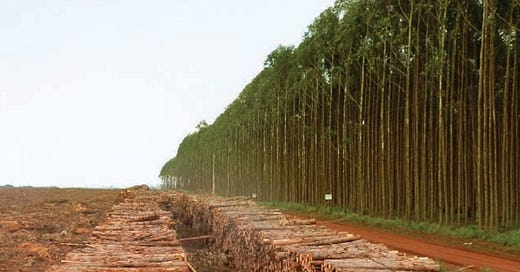12 Replies to 12 Lies about Industrial Tree Plantations
To mark this year’s International Day of Struggle Against Monoculture Tree Plantations, World Rainforest Movement has released “12 Replies to 12 Lies about Industrial Tree Plantations”. The publication exposes the most common misleading statements used by plantation companies and their supporters. It’s based on a WRM briefing put out in 1999 titled, “Ten Replies to Ten Lies”, written by Ricardo Carrere.
In the introduction to the report WRM writes that,
Planting trees can be very good, but it can also be very bad. It all depends on who is planting the trees, what they’re planting them for, the scale and location of the plantations and the damage or benefits they bring to communities.
Industrial tree plantations are once again expanding rapidly at least in part because of the myth that plantations can address the climate crisis. As WRM notes, since the 2015 Paris Agreement, “plantation companies have benefited from new funding sources and policies that favor their interests”.
Lie 5: “Plantations counteract climate change”
Climate change is getting worse. In fact, climate change is increasingly referred to as climate chaos, due to the growing frequency of extreme weather events like heat waves, floods and droughts, with the destruction and despair that they cause.
The main cause of climate chaos is well-known: the burning of fossil fuels extracted from below the earth’s surface — mainly oil, coal and gas. When these are burnt, they are very polluting, releasing, among others, a gas called carbon dioxide, among other gases. The solution is also well-known: keep the oil, coal and gas in the ground.
So, why do companies and governments say that they are saving the planet by planting trees?
While it is true that trees absorb carbon dioxide, there are important differences between the carbon that trees absorb above the ground, and the carbon released from fossil fuels extracted from below the ground.
The carbon that circulates above ground — in the air, oceans, vegetation, and soils — is often referred to as biotic carbon. It can be stored temporarily in any of these places, including in vegetation, such as trees. From there, it can easily be released naturally, through fires, storms or insect outbreaks, to name some prominent examples. Large-scale forest destruction creates an imbalance in that cycle.
Another form of this element is fossil carbon, which is in underground deposits stored over millions of years. In order to turn these deposits into fuels for energy generation, they have to be extracted using heavy machinery. When the fuels are burnt, a lot of carbon dioxide is released at once, interfering with the above-ground climate for a long time and contributing to the excessive amount of carbon that is affecting the climate.
So, having said that, why can’t plantations counteract climate change?
First of all, when carbon extracted from underground deposits is released, it interferes with the climate for a very long time — for centuries, millennia or longer. There is no way that carbon can be stored for that length of time in a plantation tree. This means that the climate interference of fossil carbon cannot be undone by planting trees. At most, trees provide temporary storage, because most industrial plantations will be harvested after a relatively short period of time.
Second, the carbon in fossil fuels is so densely packed and concentrated, that a tremendous quantity is released when a tonne of oil, gas or coal is burned. Companies could never plant enough trees to absorb all that carbon, even temporarily.
So, why do companies continue to claim that plantations can counteract climate chaos, even though this is clearly not true?
Well, they have managed to sell this idea to many individuals and entities, including most governments and investors. By claiming that the problem is about (too much) carbon in the air, and that carbon emissions can be ‘compensated’ or ‘offset’ when trees are planted, they suggest the false idea of ‘zero emissions’. Tree plantations created for this purpose, which are known as ‘carbon plantations’, are also used in a mechanism called REDD+, which has been increasingly referred to as Nature-Based Solutions (NBS) since 2019.1
Companies have been insisting on this false claim because it ensures that they can continue to develop their polluting industries and increase their profits for a longer time, despite climate chaos and the huge tragedies it causes.
Finally, plantation companies usually do not account for all of the carbon emissions that they generate, such as those from direct and indirect deforestation caused by setting up plantations, or from the extraction and burning of fossil fuels needed for their fertilizers, agrotoxins, machinery, trucks, ships, and so on.
Besides planting trees, REDD+ and also NBS erroneously argue that pollution can be “offset” by protecting carbon in forests that are at risk of being destroyed.







